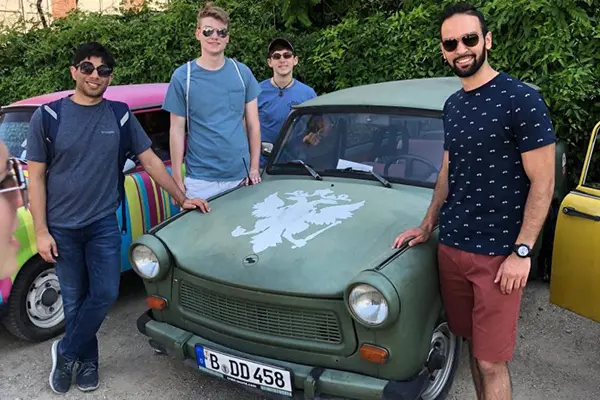Everything about cars is changing, and UML alumni and faculty are helping pave the road ahead

Faculty in UML’s Philosophy and Civil Engineering departments are collaborating on an NSF-funded project in which they’re creating computer models with PTV Group software to assess the ethical dilemmas created by self-driving cars.
10/29/2018
By Ed Brennen
The puck drops for the Homecoming hockey game at 7 p.m. “Has it really been 20 years?” you ask yourself. You fish your River Hawks T-shirt from the drawer and tell Alexa to order a car for 6:15.
Destination: the Tsongas Center.
The two-door, electric coupe—the latest model from Facebook’s autonomous transportation division—pulls up to your house at 6:14. The car’s sound system is already playing a tune from your playlist, a favorite old-school Drake song. You climb into what used to be known as the driver’s seat, smile for the facial confirmation scanner, buckle your seatbelt and sit back in your swivel chair for the 31-minute ride (according to the in-dash monitor).
As the car exits off the Lowell Connector and heads downtown, you look up from your phone’s newsfeed and think back to how congested these streets used to be. But now, as in every city, driverless cars barely slow down as they quietly weave past one another in busy intersections. Coming down Dutton Street, you can’t believe the vintage Haffner’s Gasoline “It Kicks” sign is still there, although it now points to an electric hypercharging station.
“Once upon a time, the automobile’s primary interface was the wheels hitting the road. Now, the vehicle has to interface with other vehicles and with the environment around it.” -Cuneyt Oge ’75, former president of SAE InternationalThe car pulls smoothly into the dropoff lane in front of the Tsongas Center (at 6:46 on the nose), stopping abruptly as an oblivious visiting fan steps directly in its path. As the car pulls to its final stop, you check your frequent-rider miles balance on the display before opening the door and stepping out into the cool October night.
“How we power, how we drive and how we own our vehicles … all of these things are going to change fundamentally within the span of one generation, at a level that hasn’t changed in the last 100 years—since cars have been around.”
So says industrial management alumnus Cuneyt Oge ’75, a leading voice in the automotive world. He’s worked as an industry consultant for nearly 40 years and is the former president of SAE International, a global association of more than 128,000 Society of Automotive Engineers members. SAE is helping the U.S. Department of Transportation establish guidelines for autonomous vehicle development, starting with the classification of the six levels of automation: from 0 (where the driver does everything) to 5 (where the driver doesn’t even need to be in the car).
In this emerging era of connected vehicles, where cars rely more on lidar (light detection and ranging) imaging and machine learning than carburetors and pistons, Oge says young engineers today face a phenomenal array of challenges.
“Once upon a time, the automobile’s primary interface was the wheels hitting the road. Now, the vehicle has to interface with other vehicles and with the environment around it through information and data,” he says. “All of these additional dimensions—software, connectivity, cybersecurity—are coming into the automotive space.”
As they do, they are revolutionizing how and what we drive—or what drives us. Whether it’s the promise of planet-saving electric and hybrid vehicles, the disruptive business models of ride-hailing apps like Uber and Lyft or the curious excitement that comes with seeing video clips of driverless cars navigating city streets, the transformation of personal transportation is shifting into high gear.
With this transformation comes a trunkload of new challenges and questions. What’s the best way to power the cars of tomorrow? How do driverless cars respond in life-or-death situations? What happens to the auto industry if people stop buying cars and start sharing them instead? What will our roads, cities and skies look like in 25 years? Will car crashes and greenhouse gas emissions go the way of hand-cranked windows and dashboard ashtrays?
UMass Lowell alumni, faculty and students are playing a role in this lane shift—from computer scientists to engineers, from policymakers to philosophers. Through research and innovative work, they are helping to pave the road for the future of driving.





